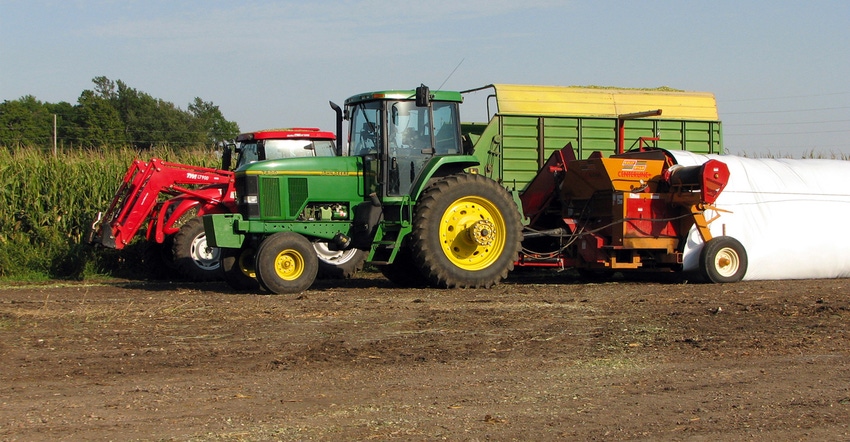August 21, 2018

Proper harvest management is critical for high-quality corn silage, and it starts with harvest timing. This ensures that the harvested crop is at the optimum moisture for packing and fermentation.
“You can��’t eyeball harvest moisture to predict when to start corn silage harvest. The old ‘milkline’ rule of thumb is too variable with modern hybrids. It’s best to subsample some plants from a field, chop them up [wood chippers work great] and subsample from this using a moisture tester to help target harvesttime.”
That observation comes from Brian Lang, Iowa State University Extension field agronomist in northeast Iowa. He cites a short article from the University of Wisconsin on whole-plant moisture variability in the field, desired moisture for various storage structures, and procedures for moisture determination of corn silage. The Tips to Help Guide Your Corn Silage is online.
When to start harvesting corn for silage
The most accurate means of checking silage moisture is with a good, reliable silage moisture tester. Directions for using a microwave oven to test crop moisture are included in this publication on corn silage for livestock from ISU.
Proper harvest management is critical for high-quality corn silage, and it starts with harvest timing, he notes. This ensures that the harvested crop is at the optimum moisture for packing and fermentation. Silage that’s too wet may not ferment properly and can lose nutrients through seepage. If silage is too dry when harvested, it has lower digestibility because of harder kernels and more lignified stover.
In addition, dry silage doesn’t pack as well, thus increasing the potential for air pockets and mold. Optimum silage moisture at harvest ranges from 50% to 60% for upright oxygen-limiting silos, 60% to 65% for upright stave silos, 60% to 70% for bags, and 65% to 70% for bunkers.
When to begin testing corn for moisture
Lang cites the following information from the University of Minnesota summarizing various aspects of corn silage harvest.
Due to variability among hybrids and growing conditions, it is necessary to measure silage moisture using a commercial forage moisture tester or microwave oven rather than simply estimating it from the kernel milkline. Instead, use the kernel milkline as an indicator of when to collect the first silage samples for moisture testing.
A general guideline is to begin moisture testing when the milkline is 25% of the way down the kernel for horizontal silos, and 40% of the way down the kernel for vertical silos. Then, assume a constant dry-down rate of about 0.6% per day, and measure moisture again prior to harvest.
Length of cut and crop processing
Length of cut and crop processing are also important for obtaining high-quality corn silage. This is because breakage of cobs and kernels increases surface area, which improves digestibility, reduces cob sorting and results in higher-density silage that packs better. Although crop processors are expensive, the higher-quality silage produced can increase milk production by 300 pounds per cow per year.
The benefit of crop processors is greatest when there are harder kernels resulting from delayed harvest or drought. When using a crop processor, the chopper-cut length can be increased to reduce horsepower requirements while maintaining optimum particle size. For unprocessed corn, the ideal chop length is 0.375-inch theoretical length of cut. For processed corn, the recommended settings are an 0.75-inch theoretical length of cut, with 0.08- to 0.12-inch roll clearance.
Best cutting height for corn silage
A 4-inch to 6-inch cutting height is generally recommended for corn silage, as it maximizes silage yield and milk per acre. However, drought-stressed corn can accumulate nitrate in the lower part of the stalk, thus increasing the potential for nitrate poisoning — particularly in older livestock on lower-energy rations. The potential for high-nitrate silage can be even worse if drought-stressed silage is harvested within 10 days of rainfall, since rainfall increases crop uptake of soil N.
Silage with high nitrate levels can be managed by dilution with other feeds, or by increasing the cutting height to 12 inches. Silage cut at this greater height has been shown to have 8% less silage yield and 2% less milk per acre. This same study found that a cutting height of 18 inches resulted in 15% less silage yield, 12% greater milk per ton, and 4% less milk per acre when compared to a 6-inch cutting height.
Increased silage quality with high cutting is due to a higher ratio of grain to stover. However, cornstalks are a good source of fiber, and the lower tonnage with high-chop silage typically makes it difficult to justify in the absence of high nitrate levels. When harvest begins, fill silos rapidly to reduce exposure of silage to oxygen and to reduce fungal growth. For bunker silos, pack silage as tightly as possible in progressive wedges, in depths of 6 inches or less.
Sources: Iowa State University, University of Minnesota
You May Also Like




